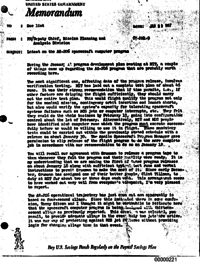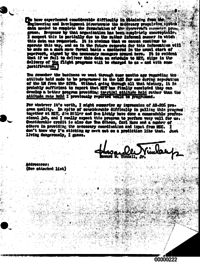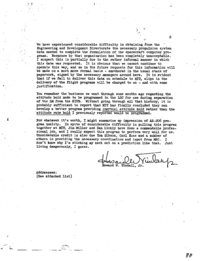See listJAN 23 196767-FM1-9FM/Deputy Chief, Mission Planning and Analysis DivisionLatest on the AS-206 spacecraft computer program
During the January 11 program development plan meeting at MIT, a couple of things came up regarding the AS-206 program that are probably worth recording here.
The most significant one, affecting date of the program release, involves verification testing. MIT has laid out a complete test plan of about 46 runs. It was their strong recommendation that if time permits, i.e., if other factors are delaying the flight sufficiently, they should carry out the entire test plan. This would flight qualify the program not only for the nominal mission, contingency orbit insertion and launch aborts, but also would verify the system's capacity for tolerating spacecraft systems failures such as RCS jets or computer interrupts, etc. They felt they could do the whole business by February 15, going into configuration control about the 1st of February. Alternatively, MIT and NSC people have identified nine computer runs which the program must execute success- fully before we would be willing to use it in flight. These mandatory tests could be carried out within the previously stated schedule with a release on about January 30. The Apollo Spacecraft Program Manager gave permission to slip release of the flight program to do the more complete job in accordance with our recommendation to do so on January 12.
You will recall our agreement with Grumman to release a program tape to them whenever they felt the program and their facility were ready. It is my understanding that we are making the first of these program releases on about January 18 along with sufficient typical test runs and verbal instructions to permit Grumman to make the most of it. Since early Decem- ber, Grumman has assigned one of their better people, Clint Tillman, to duty at MIT for about two or three days each week. This arrangement seems to have worked out very well from everyone's viewpoint, I'm very pleased to report.
The AS-206 operational trajectory has just come out and apparently is based on four-second ullage. Since this indicated there is some confu- sion, Tommy Gibson and I thought it might be worthwhile to reiterate here that the spacecraft computer program is being designed with thirteen- second ullage as previously reported. This duration was selected, you recall, to provide adequate ullage in the event only two jets are active. It was our way of protecting against RCS jet failures without providing logic for changing ullage time in that event.
We have experienced considerable difficulty in obtaining from the Engineering and Development Directorate the necessary propulsion system data needed to complete the formulation of the spacecraft computer pro- grams. Response by that organization has been completely unacceptable. I suspect this is partially due to the rather informal manner in which this data was requested. It is obvious that we cannot continue to operate this way, and so in the future requests for this information will be made on a much more formal basis – smothered in the usual stack of paperwork, signed by the necessary managers around here. It is evident that if we fail to deliver this data on schedule to MIT, slips in the delivery of the flight programs will be charged to us – and with some justification.
You remember the business we went through some months ago regarding the attitude hold mode to be programmed in the LGC for use during separation of the LM from the SIVB. Without going through all that history, it is probably sufficient to report that MIT has finally concluded they can develop a better program providing inertial attitude hold rather than the attitude rate hold I previously reported would be programmed.
For whatever it's worth, I might summarize my impression of AS-206 pro- gram quality. In spite of considerable difficulty in pulling this program together at MIT, Jim Miller and Dan Lickly have done a commendable profes- sional job, and I really expect this program to perform very well for us. Considerable credit is also due Tom Gibson, Carl Huss and a number of others in providing the necessary coordination and input from MSC. I don't know why I'm sticking my neck out on a prediction like that. Just living dangerously, I guess.
- Jan 07, 1970 – Important LM computer program change for Apollo 13 descent (4.1σ)
- Nov 03, 1966 – AGC program for AS-501/502 – Final status report (3.7σ)
- Sep 20, 1966 – Spacecraft computer program status for AS-501 (3.1σ)
- Oct 29, 1969 – Spacecraft separation procedures (3.1σ)
- Nov 01, 1966 – In which some items of interest regarding the AS-206 LGC program status are discussed (3.1σ)




